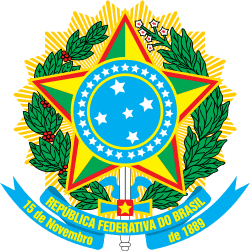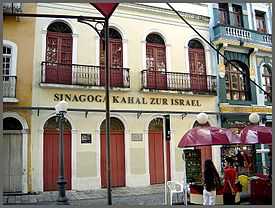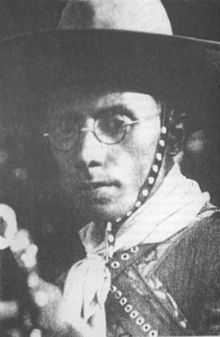History of Pernambuco
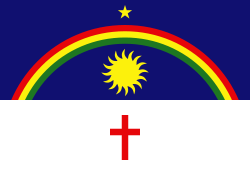
The history of Pernambuco encompasses the history since 1534 of the modern Brazilian state of Pernambuco, whose name has represented different entities at different times: a captaincy, a province, an independent Republic (briefly) and a state. Pernambuco was a distortion of Tupi para-nã (wide river) + mbuka (hollow or broken), referring to the coastal reefs; it came to mean the place where the Brazilwood tree (Caesalpinia echinata) was found, and by derivation its wood, now called Brazilwood or jacarandá. Brazilwood trees, source of a brilliant red dye, grew in abundance on the Atlantic coast of Brazil, and were the chief trading commodity of precolonial and early colonial times.
Discovery and precolonial
At the time of discovery of Brazil, the region of the modern state of Pernambuco near the Atlantic coast was populated chiefly by Tabajara Indians.
Years later, in 1516, Cristóvão Jacques was charged with patrolling the coast of Pernambuco against vessels of other nations. The feitoria (literally 'factory', a Portuguese trading post) of Cristóvão Jacques, erected at the entrance of the Canal de Santa Cruz, Itamaracá, aimed to establish a bond with the natives, seeking information about possible riches inland as well as repelling possible attacks by other nations on the Brazilian coast. The French under Bertrand d'Ornesan tried to establish a French trading post at Pernambuco in 1531.[1]
Colonial period: the Captaincy of Pernambuco
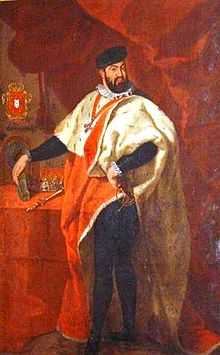
In 1534 King John III of Portugal granted the captaincy of Pernambuco to Portuguese nobleman Duarte Coelho Pereira. The captaincy of Pernambuco originally stretched for 60 leagues between the Igaraçu River, Pernambuco and the São Francisco River, and was called New Lusitania.
Coelho Pereira, an influential navigator and soldier, directed military actions against the French-allied Caetés Indians and, upon their defeat in 1537, established a settlement at the site of a former Marin Indian village, henceforth known as Olinda, as well as at another village Igaraçu, at the Igaraçu River. In addition, he started the cultivation of sugar-cane, which would have an important role in the economic history of the colony. Coelho Pereira took responsibility for most of the production of sugar, the so-called "white gold", in America and made New Lusitania one of the most flourishing captaincies.
During the Colonial Period for centuries the captaincy of Pernambuco was the most prominent of Brazil, due to growing of sugar-cane. The importance and influence of the then captaincy had become evident as early as the mid-1550s, when the governor-general Sousa oversaw all of the captaincies of the colony, except that of Pernambuco, by the requirement of its donee Duarte Coelho. Due to the cultivation of sugar, Pernambuco had become one of the few prosperous captaincies (the other notable one being São Vicente). In 1612, Pernambuco produced 14,000 tons of sugar; in the 1640s, more than 24,000 tons of sugar were exported to Amsterdam alone. While the sugar industry relied at first on the labor of indigenous peoples, especially the Tupis and Tapuyas, high mortality and economic growth led to the importation of African slaves from the late 17th century. Some of these slaves escaped the sugar-producing coastal regions and formed independent inland communities called mocambos, including Palmares.
In 1595 the favored captaincy suffered a severe blow. The English privateer James Lancaster, after picking up a chance-met separate squadron under Captain Henry Middleton, led an assault landing, seized the town of Recife and (with the assistance of a flotilla of Dutch traders who also threw in their lot with him) held it for several weeks, sailing away with the cargo of an East Indian carrack along with local plunder such as Brazil-wood.
Dutch rule

In 1630 the Netherlands West Indies Company (WIC) turned their interests to the most promising of the captaincies of the Portuguese colonies in the Americas. With the Iberian Union (1580–1640) the Netherlands, first dominated by Spain after having achieved its independence through a struggle against Spanish rule, at the same time would take the loss for the failure at Bahia. They sailed on December 26, 1629 from São Vicente, Cape Verde, a fleet of 66 ships and 7,280 men toward Pernambuco.
%2C_Count_of_Nassau-Siegen.jpg)
In February 1630 the Flemish fleet sighted Pernambuco on the horizon; most of the fleet went to the north of the captaincy because the port of Recife was well fortified and garrisoned by artillery. The landing took place on the shore of Pau Amarelo. A weak resistance was organized at the crossing of the Rio Doce, but soon defeated by the superior numbered Dutch. Olinda also did not oppose major setbacks. The few structures of defence and military disorganization contributed to a faster fall of the Portuguese defence. Then the invading troops went into the village of Recife, which would oppose a higher resistance due to already being built strong.
By 1654 the captaincy came under the dominion of the West Indies Company
. Dutch Brazil passed through important cultural, economic and social government of Count Maurice of Nassau. Olinda was a difficult point of defence; according to Dutch design, it was abandoned and burned by the Flemish troops. Nassau's government built Maritania or Mauritsstad (present day Recife) on delta islands, which had similarities to Holland's topography. Unlike Olinda, the low swamplands of Mauritsstad were easier to defend. Nassau's Dutch administration was noted for advancements in urbanism, culture, and science. Under Nassau's command, the future Recife would surpass Olinda in regional importance with the construction of bridges, schools, infrastructure and sanitation. The Dutch legacy is still recognizable, 500 years later, in Pernambuco's people, accent and architecture.
The occupation was strongly resisted and the Dutch conquest was only partially successful. The Dutch, who allowed sugar production to remain in Portuguese hands, regarded suppression of the Quilombo of Palmares important, but they were unsuccessful. Johan Maurits van Nassau-Siegen, count of Nassau, was appointed as ruler of the Nieuw Holland. This change of tack by the government, almost entirely from exploitation by Portugal to something closer to a colony of settlement, some colonists did rebel against Portugal. Among them, we have the name of Domingos Fernandes Calabar, who fought against the Portuguese resistance until the end of his life.

Pernambucan Revolt
On May 15, 1645, meeting on the São João Plantation, 18 insurgent leaders in Pernambuco signed a commitment to fight against the Dutch rule in the captaincy. With the agreement signed, thus started the counter-attack on the Dutch invasion. The first major victory of the insurgents took place on the Mount of Tabocas (now located in the municipality of Vitória de Santo Antão) where 1200 mazombos insurgents armed with guns, sickles, sticks and arrows defeated 1900 well-armed and well trained Dutch, in an ambush. The success has given leading Antonio Dias Cardoso the nickname Master of Ambushes. The Dutch who survived went on to Recife, and again defeated by an alliance of mazombos, Indians native and black slaves.
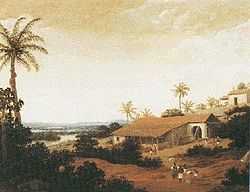
They retreated back to the fortification in Cabo de Santo Agostinho, Pontal de Nazaré, Sirinhaém, Rio Formoso, Porto Calvo and Forte Maurício, was successively defeated by insurgents. Finally, Olinda was recovered by the rebels.
Surrounded and isolated by rebel bands in their colony known as New Holland, going from Recife to Itamaracá, the invaders began to suffer from lack of food, which led them to attack cassava plantations in the villages of São Lourenço, Catuma, and Tejucupapo. On April 24 in 1646, there was the famous Battle of Tejucupapo, where peasant women armed with farm implements and arms drove out the Dutch invaders, humiliating them permanently. This historic fact established itself as the first major military participation of women in defence of the Brazilian territory.
On April 19 in 1648, the Dutch broke the siege, turning to Cabo São Agostinho. The site was the scene of two important battles of Brazilian military history – the two Battles of Guararapes. The fate of the invaders was sealed with the second Battle of Guararapes, but the invaders retained a surrounded presence until 1654. On January 20 that year, the last Dutch defences were penetrated, forcing the invaders to conclude a treaty of surrender. After 24 years of Dutch rule over Pernambuco, after 62 hours of negotiation, on January 27 in 1654 in Treaty of Taborda, the Dutch surrendered unconditionally.
The uprising was a milestone in Pernambuco, both militarily with the consolidation of ambush and guerrilla tactics, and socio-politically, with the increase of miscegenation between the three races (black African, white European and native Indian) and was the beginning of a sense of nationhood.
Jews in Pernambuco
The first Jewish families arrived in Recife in 1635, when Pernambuco was under Dutch rule, had fewer than 10,000 inhabitants and was the richest Brazilian captaincy. Pursued by the Catholic Inquisition in the Iberian Peninsula, they came attracted by the religious freedom that the Dutch began to settle on land taken from Portugal.
In Recife, the Jews entered the branch of the trade that would soon dominate: during the rule of Count Maurice of Nassau, for example, they controlled 40% of sugar exports sugar from Pernambuco to the Netherlands and Germany.
They have also played an important historical role. That they erected in the 17th century, the first synagogue in the Americas, in house number 197 Rua do Bom Jesus, in the neighborhood of Old Recife.
The first manifestation of Hebrew literary (three sentences that reported the suffering and trials passed by the Jewish people) was written by Isaak Aboab Foonseca who was the first rabbi in the Americas.
The Jewish community also left its mark on the formation and layout of the city of Recife: they have built over 300 houses and duplexes, schools, cemetery and the first bridge Recife (a Buarque de Macedo) was commissioned by Maurice of Nassau to a Jew, Baltazar Fonseca.
Many habits today are grown by Pernambucano heritage left by the Jews: paint the house at the end of the year; fix her up on Fridays; buy goods in installments at the front door, among others.
After the expulsion of the Dutch in 1654, the Jewish community in Pernambuco again suffered religious persecution by the Portuguese and left Brazil.
Of the 150 families who left Recife to Amsterdam, a group of 23 Jews ended up with their boat (the ship Valk) intercepted by Spanish pirates and imprisoned in Jamaica.
Soon after the group was released by the crew of a French ship bound for North America and left in September 1654 in New Amsterdam, was a village of 1,500 inhabitants.
It was this group of Jews that left Recife who founded the first American Jewish community and helped build what is now New York City.
In addition to these pioneers, other Jewish families would come to Recife in 1910, mostly from Russia. In 1998 the old house where ran the Recife synagogue was expropriated by the city to host, after being restored, the Centre for Documentation and Research in Jewish history.
Pernambucano revolts and conspiracies
- See Also Rebellions and revolutions in Brazil

Within Pernambuco were several riots, revolutions and conspiracies in general inspired by the French Revolution, Freemasonry and the Enlightenment. European ideas of liberty, equality and fraternity were scattered among the more fortunate Pernambucanos, usually the aristocrats of the literary devices of cane sugar. Pernambuco even existed a few months as the Republic of Pernambuco, the result of the 1817 revolution. The flag of the modern State of Pernambuco was adapted from that of the 1817 revolution.
Empire of Brazil
Brazilian Independence
Independence from Portugal was not accepted right away, soon after D. Pedro I declared Brazilian Independence he would have to consolidate his power in Brazil.
Cabanada was a popular revolt which began in 1832 after the abdication of Dom Pedro I in the areas of forest and Agreste (with reflections in the neighboring state of Alagoas), against the government of the Regency. The rebels, in general, were humble people who lived in huts,
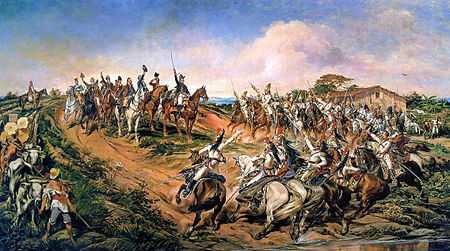
a fact which gave rise to the name of the movement.
The government mobilized a large contingent to meet the rebels, but the fighting became meaningless with the emperor's death in 1834. The rebels were dominated in 1835.
Cabanada is also the movement that resulted in the ouster of President of the province of Alagoas, Bernardo de Sousa Franco, October 5, 1844. The rebels (about a thousand armed men) were commanded by Vicente Tavares da Silva (known as Vincente de Paula), but the movement was extinguished in little over a month by troops led by Brigadier General Antônio Correia Seara.
20th century
Cangaceiros
Independent armed groups emerged in the Brazilian Northeast, which used guerrilla tactics to fight and were wanting to avenge crimes against family members or friends as well as fight for food and ammunition to their members, and often working for landlords who evicted the workers of the estates that reacted against exploitation in the county.
They were formed by people of humble origin, usually from the field, under the leadership of a chief who imposed their own concept of morality, honor, justice and piety.[2]
Gangs were pursuing isolated goals, sometimes even fighting among themselves, and had its heyday between 1922 and 1930, when terror spread throughout the semi-arid Northeast and were chased by troops from seven states; Bahia, Sergipe, Alagoas, Pernambuco, Paraíba, Rio Grande do Norte and Ceará, the officials even using airplanes in repeated, unsuccessful, search attempts.

In the struggle to capture the leader of the most feared of these bands, Virgolino Ferreira da Silva, Lampião, the Brazilian government went on to publish wanted posters promising 50,000,000 réis to whoever brought in Lampião "dead or alive."
Deeply knowledgeable of the caatinga, the gangs had support from local farmers, politicians, peasants and priests, not only for fear of the bandits, but for need of their services. The rank of Captain Virgolino Ferreira, for example, was given by Father Cícero do Juazeiro.
Besides Lampião, other bandits and outlaws have also became myths in the Northeast, outlaws like Antônio Silvino Corisco, o Diabo Louro, (the Blond Devil). The entry of women into banditry happened in 1930 when Maria Bonita became fellow Cangaceiro and followed Lampião's gang. Although the highwaymen took momentum in the early 1920s, the existence of armed groups in the Northeast comes from colonial times.
And one of the first of outlaws ever heard was The Cabeleira, in the second half of the 18th century, was active in rural areas close to Recife. According to scholars, one of the factors that contributed to the proliferation of gangs was the great drought that decimated the Northeast in 1877: extreme poverty and hunger caused thousands in the Sertão, (hinterland), with no prospect of survival, to depart for plunder, paving the way for the world of cangaceiros.
Banditry is at the origin in the very form of colonization in the Brazilian Northeast, where, financed by the Crown, the pioneers invaded the Sertão, fell forests, landmarks and paid the gunmen and bandits to eliminate the native populations to react to the occupation of their land.
The private armies maintained by the Northeastern colonels who owned the land since the Captaincies also differed on almost nothing, its methods, the bands of outlaws. The highwaymen was one of the most turbulent and contradictory times in Brazilian history and still comes up in a heated controversy: that the outlaws would have been righteous if they didn't become bloodthirsty bandits.
The end of the cangaceiros took place in 1938, when Lampião's gang was slaughtered, on the banks of the São Francisco River in Angicos, Alagoas. Corisco, o Diabo Louro, survived until 1940, but almost without doing anything to keep the promise to "avenge the death of Lampião."
The Modern state
Cassava Scandal
One of the largest financial scandals in the history of Pernambuco, occurred in 1980 at the Bank of Brazil in Floresta, involving ~$700 million and several influential people in the state.
Loans were made by the bank for planting cassava, then it was alleged that drought had destroyed the plantations (which were never actually planted) and damages were recouped by crop insurance. Even the bank manager was involved. In July 1981, the Pernambucano press exposed the hoax, and a federal court inquiry ensued. The money was never actually diverted.
On March 3, 1982, District Attorney Pedro Jorge de Melo in charge of the inquiry was assassinated in Olinda. The crime had national repercussions. The trial of seven defendants in the death, among them MP Major José Ferreira dos Anjos, in October 1983 at the jury of Recife, resulted in sentences of 31 years imprisonment for each of the defendants.
In Nov. 1983, Major José Ferreira escaped from prison. He was recaptured in Jan. 1996, in the interior of Bahia and returned to prison in Recife.
See also
- War of the Peddlers 1710 to 1711
- Conspiracy of Suassuna 1801
- Confederation of the Equator 1824
- Praieira Revolution 1848 to 1850
- Timeline of Recife
References
- ↑ Renaissance Warrior and Patron: The Reign of Francis I by R. J. Knecht p.375 (Cambridge University Press, 1996)
- ↑ Paulo Gil Soares, in Vida, paix~ao e mortes de Corisco, o Diabo Louro
Further reading
- "Local History, Brazil: Pernambuco". Catalog of the William B. Greenlee Collection of Portuguese History ... in the Newberry Library. Chicago: Newberry Library. 1953 – via Hathi Trust.
| ||||||||||||||||||||||||||||||||||||||
| ||||||||||
